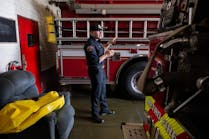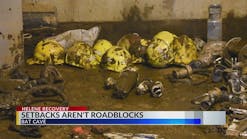Disability Access Concerns Delay Opening of Calif. Fire Station
Source The Press Democrat, Santa Rosa, Calif. (TNS)
Santa Rosa’s use of its $4 million Fountaingrove fire station has been delayed by questions about whether the new building is sufficiently accessible to people with disabilities.
The 5,300-square-foot Newgate Court station was supposed to be ready for occupancy in April, but last-minute inspections by city staff trained in the requirements of the Americans with Disabilities Act highlighted numerous potential violations.
The discovery has perplexed many at City Hall, especially given that the city has spent about $6 million over the past five years improving the accessibility of existing buildings, parks and sidewalks under the watchful eye of the U.S. Department of Justice.
It’s still unclear whether there are actually significant ADA or building code violations in the station. The Fire Department has hired an outside ADA consultant to review the facility and help determine what, if any, shortcomings exist, what changes need to be made, and how much they’ll cost.
“The building is ADA-accessible,” said Santa Rosa Fire Chief Tony Gossner. “What we’re struggling with is does it need to be fully accessible, and if so, what does that mean?”
The nine firefighters who will work and live in Station 5 are able-bodied by definition and obviously don’t require toilets, showers and countertops in the station to be wheelchair accessible. But as a public facility built with public money, questions have come up about how much of the building needs to be open to the public and therefore ADA-accessible.
The building was clearly designed with a degree of accessibility in mind. There is a disabled parking spot and pathway directly in front of the building. The lobby has a counter with a section lowered for people in wheelchairs to access.
Whether other parts of the building — such as the kitchen, dining room, lounge and bathrooms — need to be ADA accessible is an open question.
After a city facilities staff person raised questions in April, city building inspector Don Folsom performed an assessment and found 43 different potential compliance issues. Some, like the location of a grab bar or toilet paper holder in the bathroom, are minor and inexpensive to fix.
Others could be major expenses, such as removing the entire kitchen island because there is not enough room for someone in a wheelchair to maneuver around it, or taking out shower stalls because they’re not wide enough.
“That would be very disappointing,” Gossner said.
The department views most of the areas in the station as work areas for firefighters only. This includes the kitchen, dining room, lounge and living quarters, as well as the fire engine bays, Gossner said.
If any members of the public are in the facility, such as for a tour, firefighters would be with them at all times and able to accommodate their special needs if necessary, he said.
Some of the proposed requirements have struck Gossner as downright silly. For example, there are knobs on the walls throughout the station that control the volume of the radio system that alerts firefighters to calls being dispatched. Even if a member of the public were in the station, they have no reason to touch those controls and should not be doing so, Gossner said.
Nevertheless, these controls were identified as requiring a “pinch and twist” motion that may not be allowed for ADA- accessible areas, Gossner said. A sliding switch was recommended instead, he said.
“It’s a little bit like, ‘Huh?’?” he said, scratching his head in confusion.
Some of the issues that have been identified are frustrating because of how close they are to meeting the standards, he said. A bookshelf in the lounge is 35 inches high, but may need to be 34. The shower entrance that is 58¾ inches wide may need to be 60 inches wide to comply.
City Manager Sean McGlynn said it is too soon to say how big the problem is, but he plans to get to the bottom of it. He said he expects the forthcoming consultant’s report will be instructive.
“Now we have to get into a deeper dive to see what is really an issue,” McGlynn said.
He said he’s more concerned about the city’s internal processes, and has asked Public Works Director Jason Nutt to come back in 60 days with a report about how the city got to this place.
“I have some questions about whether we’re in best practices mode,” he said.
The issue first became public during a City Council meeting when Councilwoman Julie Combs indicated she had heard of problems with an unfinished city building.
The fire station originally was designed around 2010 by architect Mitch Conner of Santa Rosa-based Archilogix and was built beginning in 2014 by GCCI Inc., also of Santa Rosa.
“We built the building per plans and specifications,” said Michael Gentry, president of GCCI.
Conner said he designed the building to the 2010 California building codes and to the 1991 ADA standards, both of which where applicable at the time the building was permitted.
The problem was that the city put construction on hold for several years due to a lack of financing. When the project was “reactivated” in 2013, some revisions were made that eliminated the lobby bathrooms, opting instead to allow visitors to use the bathrooms in the quarters, Conner said.
“I get kind of ticked off when I hear people say this wasn’t designed to code, because it was,” Conner said.
He said the issue gets complicated because an argument can be made that even if the public doesn’t have access to all of the building, other city officials, such as facilities maintenance or technical support staff, might have disabilities and need full access, Conner said.
“It’s like pulling the thread on a cheap suit,” he said.
Building official Mark Setterland said it can be confusing because state building codes and the federal ADA requirements are separate but interrelated. The state codes had evolved over time to become more consistent with the ADA, and the latest update in 2013 made their requirements virtually identical.
What codes a building permitted in 2010 but constructed in 2014 needs to conform to is one of the key outstanding questions, Setterland said.
“How it is we got here and what we do now and what the legal ramifications are, if any, are what we’re trying to suss out,” Setterland said.
The city has hired Kim Blackseth, a Napa-based expert in ADA compliance, to assess the building and suggest solutions, Gossner said.
Blackseth, who uses a wheelchair himself, toured the building Thursday and is expected to issue a full report in a few days. Blackseth said he thought the entire building, even work spaces and truck bays, needs to be ADA compliant, Gossner said.
“It looks like we will have to do something with the kitchen differently,” such as removing the island or lowering the counters, Gossner said.
But Blackseth also made a number of suggestions that may make fixing the issues manageable, Gossner said.
You can reach Staff Writer Kevin McCallum at 521-5207 or [email protected]. On Twitter @srcitybeat.
———
©2015 The Press Democrat (Santa Rosa, Calif.)
Visit The Press Democrat (Santa Rosa, Calif.) at www.pressdemocrat.com
Distributed by Tribune Content Agency, LLC.





